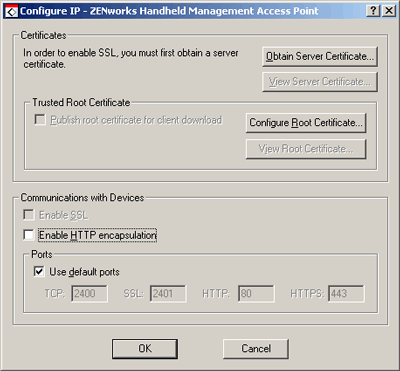B.2 Configuring SSL and HTTP Communication between the ZENworks Handheld Management Access Point and the Handheld Devices
You can configure the SSL and HTTP communication between the ZENworks Handheld Management Access Point and the Handheld devices by using cfgip.exe from the zfhap directory.
We recommend you to use SSL for communication between the ZENworks Handheld Management Access Point and the Handheld devices because SSL provides the following primary security services:
-
Message Privacy: All transmissions after the initial handshake between the ZENworks Handheld Management Access Point and the Handheld device are encrypted.
-
Session Integrity: A secure channel is opened between the ZENworks Handheld Management Access Point and the Handheld device.
-
Mutual Authentication: The ZENworks Handheld Management Access Point and the Handheld device can establish their authenticity.
-
Launch cfgip.exe from zfhap directory.

-
Obtain a server certificate before using SSL.
NOTE:Palm devices do not support adding root certificates that are bundled with them by default.
-
In the Configure IP - ZENworks Handheld Management Access Point dialog box, click .
-
Review the information on the Certificate Wizard page, then click .
-
In the option, specify the name of the machine as specified during the installation of the ZENworks Handheld Management Access Point.
For example, if IP address is specified during the installation of the ZENworks Handheld Management Access Point, you must specify the IP Address in the option. If the DNS name is specified during the installation of the ZENworks Handheld Management Access Point, you must specify the DNS name in the option
NOTE:If you want to connect your PPC 2000 device using SSL, you must keep in mind the following points:
-
The server address is stored as the IP address because the Domain Name Resolution does not work on PPC 2000 devices.
-
If the PPC 2000 device is connected using IP client through wireless, you must specify the IP address of the ZENworks Handheld Management Access Point instead of the common name when you create the Certificate Signing Request (CSR). This enables the device to validate the Certificate server. But if the device cradle syncs, you can use the common name by selecting the settings option in the ZENworks Console that is available on the device.
-
-
Click .
-
Specify information for your geographic location in the , , and text boxes, then click .
-
Specify information about your organization and organizational unit, then click .
-
Specify the location in which you want to save the certificate request, then click .
-
Click , then click .
NOTE:To use NCS: In ConsoleOne, click , click , then follow the prompts. When having the certificate signed (if given a choice), have it saved in Base64 format.
Handheld PCs running Windows CE 3.0 and Pocket PC 2000 devices do not support certificates originating from NCS.
-
-
Have the certificate signed by a Certificate Signing Authority, such as Novell Certificate Services (NCS) or VeriSign. To have the certificate signed by NCS, continue with Step 4, else skip to Step 5.
-
(Conditional) Perform the following steps to have the certificate self-signed by NCS:
-
Launch Consoleone
-
In the left pane, click .
-
In the right pane, double-click the Certificate Authority for the tree.
-
In the Properties dialog box that displays, click . Click .
-
Click Validate. Ensure that the status in the Certificate Validation dialog box displays , then click .
-
Click , then click .
-
Select then click to save the exported certificate in a Base64 format.
-
-
To import a server certificate before using SSL:
-
In the Configure IP - ZENworks Handheld Management Access Point dialog box, click .
-
Click .
-
Ensure that the option is enabled, then click .
-
Browse to the location where you saved the certificate during Step 4.g, then click .
-
Click .
-
Click .
-
-
You can publish a trusted SSL root certificate that Windows CE clients automatically download when they connect. This should be the root certificate of the Certificate Authority used to sign your server certificate.
If you are using a third-party Certificate Signing Authority and the root certificate does not already exist on the PC or handheld device (for example, a root certificate from NCS), you can publish the root certificate so that is automatically downloaded.
To publish a trusted SSL root certificate:
-
In the Configure IP - ZENworks Handheld Management Access Point dialog box, click .
-
Browse to and select the signed root certificate, then click .
The root certificate that you get from a Certificate Authority (CA) must be in Base64 format.
-
Click twice.
-
-
To enable the SSL on the ZENworks Handheld Management Access Point, select the check box.
-
To enable HTTP on the ZENworks Handheld Management Access Point, select the check box.
-
To enable SSL/HTTP on a handheld device, open the ZENworks console and do the following:
-
For PalmOS devices, select the server from the drop-down list and select .
or
For Windows CE devices, click Configure, then click .
If you are publishing a root certificate, click .
-
To enable HTTP for Palm devices, select from the drop-down list, then click .
or
For Windows CE devices, click , then click .
-